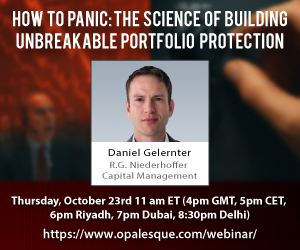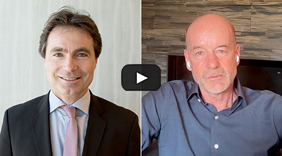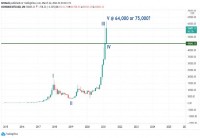|
Opalesque Industry Update - It had to get worse before it got better. >> The Lyxor Hedge Fund Index was up+0.9% in August 2014 (YTD +1.7%). 8 out of 12 Lyxor Indices ended the month of August in positive territory, led by the Lyxor CTA Long Term Index (+5.8%), the Lyxor CTA Short Term Index (+3.2%) and the Lyxor Long Short Equity Market Neutral Index (+2%). >> The correction which started at the end of July, prolonged until mid-August amid rising geopolitical strains. It was driven by a derisking across all European asset classes and by a repricing of risk premium in the least liquid assets. Equity and credit exposed strategies suffered the most over the period. Hints at an ECB reflation and robust US data triggered a rally. Directional strategies and the ones less exposed to illiquids then benefited the most from the bounce back, which unfolded until the end of the month. CTAs, L/S Equity and Sovereign Fixed Income Arbitrage were the outperformers of the month. >> L/S Equity participated in the post-correction rally and produced alpha. European equities corrected more and rebounded less, which adversely impacted managers focused on the region. Small cap, financials and domestic demand stocks corrected sharply. Conversely, the capex and cyclical sectors, unfavored for months, showed resiliency. Such rotation was better managed by European managers. In the US, small caps and financials took a severe hit, echoing the repricing in illiquid premiums. Contrarian profit taking on the recent outperformers (utilities and energy) and a temporary correction in M&A driven positions also detracted performance in the earlier part of the month. US cyclical, capex sectors and stocks with a corporate action catalyst, quickly rebounded afterward. US funds, which are heavily exposed to these segments, participated in most of the rally. EM focused managers enjoyed a much smoother start of the month. EM markets remained fairly isolated from the sell-off, due to dovish central banks and limited upward trend in USD. L/S equity managers ended the month in the positive territories. Interestingly, they shaved off positions in most of their sector exposures in favor of financials, where they expect a catch-up. Persisting low interest rates and a tame global recovery continued to weigh on financials valuations. However, the expected ECB reflation and improved credit risk to come out of the asset quality review (AQR) and the stress tests are favorable catalysts. >> Several issue-specific disappointments impacted both Merger Arbitrage and Special Situation funds over the month. Volatility persisted in the Athabasca Oil and the Allergan situations. In the earlier part of the month, most positions endured a clear risk-aversion correction. Merger funds fully recovered in the second part of the month, boosted by the rally in liquid M&A driven stocks and by newly announced operations in the healthcare sector. They outperformed Special Situation funds. Indeed, the latter regained only part of the lost ground, as pressure remained on the least liquid positions. The correction, which started to reprice illiquid risk premiums (in HY, loans, distressed, micro caps and activist positions) was the first real-life stress-test for Event Driven year to date, a manageable one though. >> Gamma trading provided a modest contribution to Convertible Arbitrage funds, courtesy of a short term spike in implied volatility. These opportunities quickly evaporated. Their credit and equity exposures had limited or negative contribution, especially in event catalyst issues. L/S Credit Arbitrage funds were negatively impacted by the developments in the Argentine default and Banco Espirito situations. They were also impacted by adverse credit markets, especially in the HY segment. In the second part of the month, the riskier issues played catch-up, but of limited amplitude. Just like Special Situation managers, L/S Credit only partially recovered the lost ground. >> CTAs had a rough beginning of the month, hit on their equity exposure and on several steepening bond positions. The break in the long term European equities’ trend led models to a significant cut in exposures by mid-month. The decorrelation between bonds and equities then played out very nicely for CTAs, where they held long positions. Funds also made returns on their short Euro positions. The commodity exposure was a mixed bag this month. Short term models also outperformed in August, boosted by trends unfolding on the way down and on the way up. >> Global Macro funds only partially recovered from the losses recorded in early August. By then, gains in short Euro positions didn’t make up for losses in other long FX positions against the USD. Their aggregated long bond and equity exposures also detracted performance, but the main surprise came from the commodities exposure, where they held long precious metal and energy positions. Since May, they had raised their net exposure to the asset class from 15 to 25%, with a view to capture relative value opportunities and hedge against geopolitics. In August however, amid surging risks in Ukraine and Middle East, the counter-intuitive retracement in both oil and gold inflicted significant losses. >> “Volatility may be at an inflexion but is unlikely to surge meaningfully before 2015. Persisting low growth and volatility in Q4 may continue to constrain directional traders and alpha generators, while favoring relative value and illiquid sensitive strategies”, says Jean-Baptiste Berthon, senior cross asset strategist at Lyxor AM. From: Lyxor All Barometer, September 2014 Bg |
Industry Updates
Lyxor Hedge Fund Index was up 0.9% in August (YTD +1.7%)
Wednesday, September 10, 2014
|
|





 RSS
RSS









